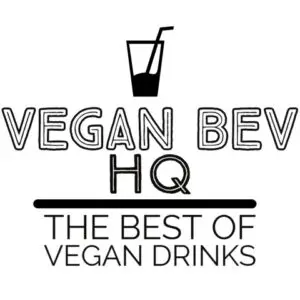Is Champagne Vegan? Let’s face it if you have any type of important event occurring you bust out the champagne. Getting married – let’s drink some champagne. Having a baby – champagne (perhaps not the expecting mother). Launching a ship – smash it with a bottle of champagne. Won a Grand Prix – spray everyone with Champagne. Getting married in Russia – smash some champagne glasses on the floor. Graduating – drink some champagne. Won the lottery – drink some champagne. Giving a toast – champagne…I could go on and on and on.
As a species, we are inundated with occasions where we must drink champagne. You can’t escape it. This inescapable reality only crossed my mind when I was at a wedding and toasting the future life of the bride and groom. After recently writing Why Is Wine Not Vegan – How To Know The Truth it got me thinking: “well, if wine can not be vegan, what about champagne – it is the same stuff…right?!”. Is Champagne vegan?
Is Champagne Vegan?
As a general rule, not all champagne is vegan. This is because Champagne is made from wine and many wines are clarified in a process called “fining” using non-vegan ingredients such as Gelatin, Isinglass (dried fish bladders), Casein (Milk Protein), Egg Whites, and/or Skimmed Milk. However, many of the most well-heard brands of champagne are vegan as they use vegan fining agents such as Carbon (Charcoal), Bentonite Clay, PVPP or allow for the wine base to naturally fine over time.
Is Champagne Vegan – What is Champagne?
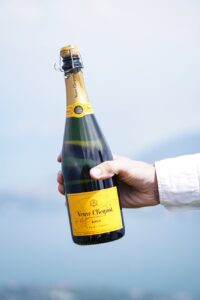
Not every sparkling wine is “Champagne”. The topic of what can and can not be called “Champagne” is a particularly touchy subject. Whilst all Champagne is sparkling wine, not all sparkling wine is Champagne. Let me clarify (see what I did there?)
You see the term “Champagne” is a protected term in the EU. In order for a wine to be called Champagne it must: (1) be from the Northern “Champagne” region of France; (2) be made from Pinot Noir grapes, Chardonnay grapes, and Pinot Meunier grapes; and (3) made using the methode champenoise (I’ll break that down below for you).
Is Champagne Vegan – What About “Champagne” Outside of Champagne?
“Hold on a minute. I have had “Champagne” here in the US and it said made in California and was definitely called “Champagne”? And you would be right.
In America, US Champagne is protected by the Protested Designation of Origin (PDO) which prevents Sparkling Wine produced outside of the Champagne area from being called Champagne in the USA. The only exception is that the PDO was accepted by the American Administration on 10 March 2006.
This means “Champagne” makers in the US that were labeling their sparkling wines as “Champagne” before 10th March 2006 can continue to call their products “Champagne”. That is why you will still see California brands like Andre selling bottles called Champagne.
Makes sense? The Champagne Region takes the production of the “Champagne” name extremely seriously. There is even an organization dedicated to that one task – Comité Champagne (they even have a Champagne Bureau located in Washington D.C.). Not surprising when over 300 million bottles of official “Champagne” are sold each year worth a whopping $3.8 billion to $5 billion.
Is Champagne Vegan – How Popular Is Champagne Across the World?
Which country is the biggest drinker of Champagne? The top spot goes to France which drinks 102,2 million liters a year, followed by the United Kingdom (22,6 liters), and then in third place is the USA which drinks 20,5 million liters per year (Euromonitor International).
Top Champagne Markets by Total Volume In 20201
| Spot | Country | Volume (million liters) |
|---|---|---|
| 1 | France | 102,2 |
| 2 | United Kingdom | 22,6 |
| 3 | USA | 20,5 |
| 4 | Australia | 16,0 |
| 5 | Japan | 10,7 |
| 6 | Germany | 08,4 |
| 7 | Belgium | 07,5 |
| 8 | Italy | 05,5 |
| 9 | Switzerland | 04,8 |
| 10 | Spain | 04,4 |
Is Champagne Vegan – How Is It Made?
The best way to understand if Champagne is vegan is to understand its production process and ingredients. In this section, I will try and break down each stage of the Champagne-making process. Champagne goes through a 10-stage process: harvesting, pressing, first fermentation, assembling, second fermentation, aging, riddling, disgorging, dosage, and corking. All of this is undertaken to add fizzy bubbles to the wine. Fun fact, there are over 49 million bubbles in a bottle of 750 ml champagne, and on average Champagne is 3 times more carbonated than beer.
What about wine?
Do you want to also know if wine is vegan? Are you wondering how it is made differently from champagne? Then you can also check out my article completely on wine: Why Is Wine Not Vegan – How To Know The Truth or if you are interested in beer check out: Is Beer Vegan? Introducing The Secret To Finding Out.
Step 1: Harvesting
This step is exactly as it sounds – picking grapes to use to make the wine base for Champagne. The most used grapes are Pinot Noir, Chardonnay, and Pinot Meunier. Bottles labeled “blanc de blancs” are made using white grapes. Bottles labeled as “blanc de noirs” are made using red grapes.
Step 2: Pressing
Again, self-explanatory. This involves pressing the grapes into a mush in which sugar and yeast can be added to start the fermentation process.
Step 3: First Fermentation
The first fermentation is designed to ferment the natural sugar out of the wine. It normally takes place in a tank (or a barrel) and the result is an acidic dry still wine.
Step 4: Assembling
In this stage, the grapes from different vineyards are combined and blended. Pinot Noir, Chardonnay and Pinot Meunier are mixed to create the unique signature flavor and style of that particular Champagne brand. Think of this as the secret recipe for each Champagne brand.
Step 5: Second Fermentation
The Second Fermentation then takes place in the bottle. The assembled mixture is put into bottles along with some yeast. The bottles are then placed on their sides between pieces of wood and left to ferment in the bottom. This process can take up to three months to complete. It is during this second fermentation that champagne will produce its unique bubbles as the yeast slowly converts sugars into carbon dioxide and alcohol.
Step 6: Aging
A byproduct of the second fermentation is spent yeast cells, called lees. There are strict rules for how long a wine must be left to age with the lees in its bottle. A minimum of months for non-vintage wines and 3 years for vintage-dated bottles. It is during this process that the interaction with the lees can give the wine unique and characteristic yeasty or bread dough aromas.
Stage 7: Riddling
Riddling is the process of removing the lees from the bottle. During this process, a bottle is placed upside down in a holder at an angle of 45 degrees. Every day the bottle is then manually turned by 1/8th turn. In doing this the lees sediment is moved to the top of the bottle where it can be removed in the next step. According to Bollinger, the Riddler will make 50,000 turns each day.
Step 8: Disgorging
Disgorging is the process of placing the bottle upside down in an ice bath. This will then freeze the yeast collected in the neck of the bottle from the Riddling process. The cap is removed and the natural carbon dioxide in the bottle pushes out the collected yeast. The bottle loses a small amount of champagne in the process.
Step 9: Dosage
To replace the small amount of wine lost through disgorgement a small amount of still sweet wine will be added to the bottle. The level of sweetness of this added wine is what determines the overall sweetness of the Champagne and how it is labeled. For example, Extra Brut (the least sweet), Brut (dry), Sec (slightly sweet), or Demi-Sec (frankly sweet).
Step 10: Corkage
The final step is corking the bottle with the famous cork and metal cage. A cork is added, and the metal cage is added to prevent the cork from being released by the pressure from the bubbles inside the bottle.
FYI, you should take the pressurized nature of Champagne seriously. In my research, I came across something that said you are more likely to die from a Champagne-related incident than from a poisonous spider bite – and nearly a third of Champagne deaths occur at weddings. In fact, 24 people a year die from Champagne corks. You have been warned.
So, Is Champagne Vegan?
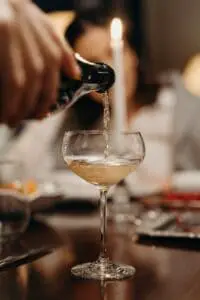
Based on the above manufacturing process it does seem that Champagne is vegan. The production process is completely different from the wine which often fails to be vegan due to the fining stage – something which doesn’t happen in champagne making.
The issue, however, is the base that the champagne manufacturer use and the wine used to top up in the Dosage process. If they use a base wine that has already been fined and then use it in the champagne – it will not be vegan. This is especially the case for Sparkling Wines which are produced outside of the Champagne Region and do not have to follow as strict and conforming production processes.
The only way to be sure is to contact the Champagne manufacturer. Alternatively, there is also a great resource called Barnivore which is a directory for finding out if wine or other alcoholic drinks are vegan – they regularly reach out to the manufacturing brands to make sure.
Is Champagne Vegan – What Champagnes are Vegan?
To help out as much as possible, I have listed below all of the most well-known Champagnes on the market and whether they are vegan or not.
Vegan Champagnes
Lanson
Moet & Chandon
Dom Perignon
Laurent-Perrier
Taittinger
Veuve Clicquot
Cattier
Krug
Nicolas Feuillatte
Louis Roederer* (they used to use isinglass but stopped using it back in 2014 and are now vegan).
Perrier-Jouët* (but not the Brand Brut)
Champagne Palmer
Champagne Thienot
Non-Vegan Champagnes
Bollinger – uses gelatine
Billecart-salmon – use isinglass
Champagne Gremillet – use milk casein
Is Champagne Vegan – The Final Sip
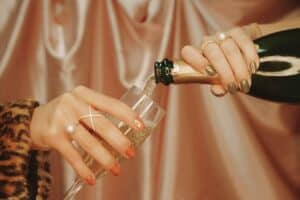
Champagne, Champers, Bubbly – whatever you call it – Champagne is a part of the way we celebrate life. It is a special drink, for happy times and memorable moments. Thankfully, for the most part, Champagne, especially the “proper stuff” does tend to be vegan (just see the above list). However, Sparkling Wines which fall outside of the “Champagne” certificate will most likely be non-vegan. This is because they are not required to follow set production and manufacturing methods. The result is a wine that has been fined with animal byproducts. Furthermore, until labeling laws change and become completely transparent manufacturers will remain under no obligation to list allergens or if their products contain animal byproducts.
The good news is that the industry is slowly changing. More wine producers are labeling their wines are “non-fined” or “vegan” and hopefully, this will also influence Champagne producers.
Until then always double-check your Sparkling Wine or Champagne – and most importantly watch out for that cork.
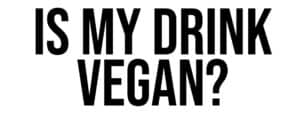
…now you know.
Beverage makers may change ingredients and/or manufacturing processes. Always double-check ingredients before purchasing any beverages.
Like What You Are Reading
Like this article, want to find out more? Want to know if your favorite Root Beer, Soda, Wine, Beer, or even if your morning coffee (yes, your morning coffee) is vegan? Then check out some of our other articles and sign up for our newsletter below:
- Is Alcohol Vegan? How To Know The Truth
- Why Is Wine Not Vegan – How to Know The Truth?
- Is Beer Vegan – Introducing The Secret To Finding Out
- Is Orange Juice Vegan? Revealing Why You Need To Know
- How To Actually Order Vegan Starbucks Drinks
- How To Find Out “Is Boba Vegan”
- Is Cream Soda Vegan? Unlock All You Need To Know
- Is Root Beer Vegan? Unlock The Hidden Root Cause
- Is Soda Vegan? Revealing What You Need To Know
- Vegan Baileys – The Truth About This Surprising Drink
- Is Coffee Vegan? How To Find Out The Truth
- Is Kombucha Vegan? The Complete Facts You Need To Know
References-
Vegan and non-vegan champagnes on Barnivore
